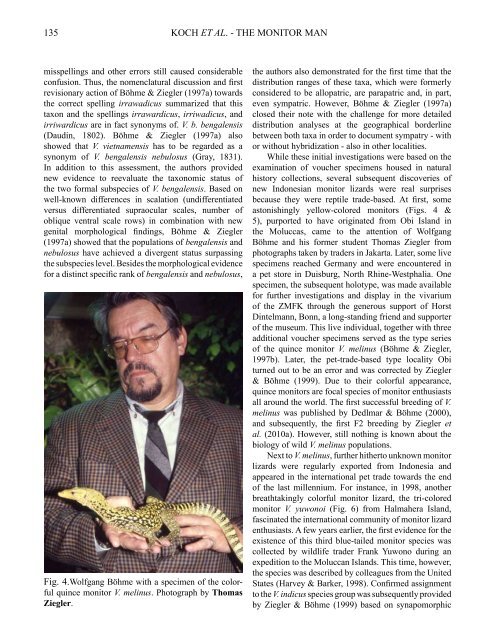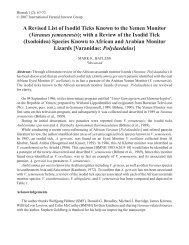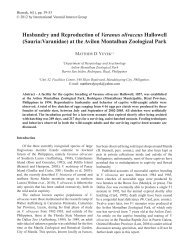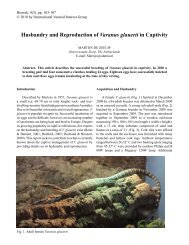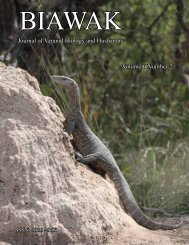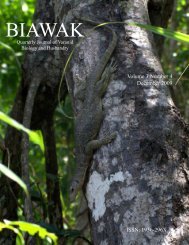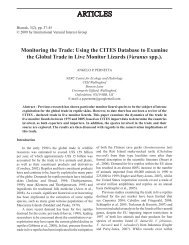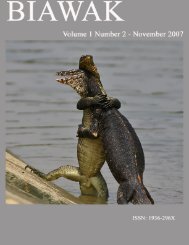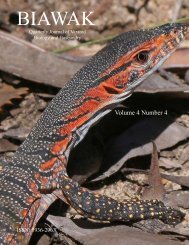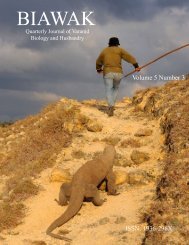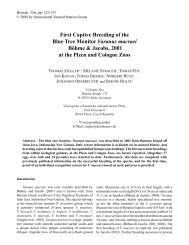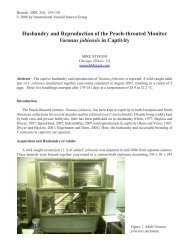BIAWAK - International Varanid Interest Group
BIAWAK - International Varanid Interest Group
BIAWAK - International Varanid Interest Group
- No tags were found...
Create successful ePaper yourself
Turn your PDF publications into a flip-book with our unique Google optimized e-Paper software.
135 KOCH ET AL. - THE MONITOR MAN<br />
misspellings and other errors still caused considerable<br />
confusion. Thus, the nomenclatural discussion and first<br />
revisionary action of Böhme & Ziegler (1997a) towards<br />
the correct spelling irrawadicus summarized that this<br />
taxon and the spellings irrawardicus, irriwadicus, and<br />
irriwardicus are in fact synonyms of. V. b. bengalensis<br />
(Daudin, 1802). Böhme & Ziegler (1997a) also<br />
showed that V. vietnamensis has to be regarded as a<br />
synonym of V. bengalensis nebulosus (Gray, 1831).<br />
In addition to this assessment, the authors provided<br />
new evidence to reevaluate the taxonomic status of<br />
the two formal subspecies of V. bengalensis. Based on<br />
well-known differences in scalation (undifferentiated<br />
versus differentiated supraocular scales, number of<br />
oblique ventral scale rows) in combination with new<br />
genital morphological findings, Böhme & Ziegler<br />
(1997a) showed that the populations of bengalensis and<br />
nebulosus have achieved a divergent status surpassing<br />
the subspecies level. Besides the morphological evidence<br />
for a distinct specific rank of bengalensis and nebulosus,<br />
Fig. 4.Wolfgang Böhme with a specimen of the colorful<br />
quince monitor V. melinus. Photograph by Thomas<br />
Ziegler.<br />
the authors also demonstrated for the first time that the<br />
distribution ranges of these taxa, which were formerly<br />
considered to be allopatric, are parapatric and, in part,<br />
even sympatric. However, Böhme & Ziegler (1997a)<br />
closed their note with the challenge for more detailed<br />
distribution analyses at the geographical borderline<br />
between both taxa in order to document sympatry - with<br />
or without hybridization - also in other localities.<br />
While these initial investigations were based on the<br />
examination of voucher specimens housed in natural<br />
history collections, several subsequent discoveries of<br />
new Indonesian monitor lizards were real surprises<br />
because they were reptile trade-based. At first, some<br />
astonishingly yellow-colored monitors (Figs. 4 &<br />
5), purported to have originated from Obi Island in<br />
the Moluccas, came to the attention of Wolfgang<br />
Böhme and his former student Thomas Ziegler from<br />
photographs taken by traders in Jakarta. Later, some live<br />
specimens reached Germany and were encountered in<br />
a pet store in Duisburg, North Rhine-Westphalia. One<br />
specimen, the subsequent holotype, was made available<br />
for further investigations and display in the vivarium<br />
of the ZMFK through the generous support of Horst<br />
Dintelmann, Bonn, a long-standing friend and supporter<br />
of the museum. This live individual, together with three<br />
additional voucher specimens served as the type series<br />
of the quince monitor V. melinus (Böhme & Ziegler,<br />
1997b). Later, the pet-trade-based type locality Obi<br />
turned out to be an error and was corrected by Ziegler<br />
& Böhme (1999). Due to their colorful appearance,<br />
quince monitors are focal species of monitor enthusiasts<br />
all around the world. The first successful breeding of V.<br />
melinus was published by Dedlmar & Böhme (2000),<br />
and subsequently, the first F2 breeding by Ziegler et<br />
al. (2010a). However, still nothing is known about the<br />
biology of wild V. melinus populations.<br />
Next to V. melinus, further hitherto unknown monitor<br />
lizards were regularly exported from Indonesia and<br />
appeared in the international pet trade towards the end<br />
of the last millennium. For instance, in 1998, another<br />
breathtakingly colorful monitor lizard, the tri-colored<br />
monitor V. yuwonoi (Fig. 6) from Halmahera Island,<br />
fascinated the international community of monitor lizard<br />
enthusiasts. A few years earlier, the first evidence for the<br />
existence of this third blue-tailed monitor species was<br />
collected by wildlife trader Frank Yuwono during an<br />
expedition to the Moluccan Islands. This time, however,<br />
the species was described by colleagues from the United<br />
States (Harvey & Barker, 1998). Confirmed assignment<br />
to the V. indicus species group was subsequently provided<br />
by Ziegler & Böhme (1999) based on synapomorphic


